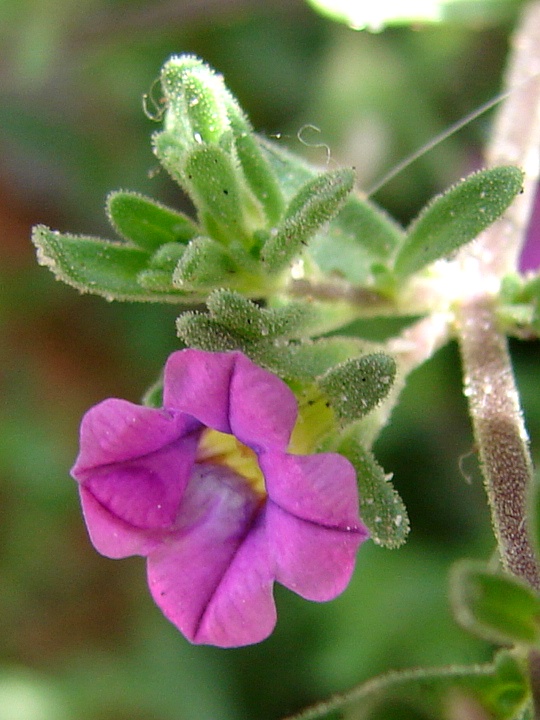Description
Taxonomy
| Kingdom | Phylum | Class | Order | Family | Genus |
|---|---|---|---|---|---|
| Plantae | Magnoliophyta | Magnoliopsida | Solanales | Solanaceae | Calibrachoa |
Synonyms
Invasion History
Chesapeake Bay Status
| First Record | Population | Range | Introduction | Residency | Source Region | Native Region | Vectors |
|---|---|---|---|---|---|---|---|
| 1877 | Unknown | Unknown | Introduced | Regular Resident | South America | South America | Shipping(Dry Ballast) |
History of Spread
Calibrachoa parviflora (Seaside Petunia) is a tropical American plant, native from Mexico (possibly also native to Gulf States and CA (CalFlora Database 2000) into South America. It occurs on sea beaches and, as a waif, in ports and inland waste areas (Fernald 1950; Gleason 1963; Gleason and Cronquist 1991). In the 19th century, C. parviflora was recorded in several East Coast ports, including Philadelphia (1864, Smith 1867) and Brooklyn (1878, Brown 1879), but is not known to be established in the Northeast.
Calibrachoa parviflora was collected in 1877 in East Baltimore, and again on ballast in 1891, along Baltimore Harbor (U.S. National Herbarium collections). It was recorded in 1938 from a salt marsh at Wachapreague, VA, on Burtons Bay (Tatnall 1946), and in the 1950s from Canton, on chrome ore piles near Baltimore Harbor. We have no later records. However, it is still included in Harvill et al’s (1992) 'Atlas of the Virginia Flora'.
References- Brown 1879; CalFlora Database 2000; Harvill et al. 1992; Natural Resources Conservation Service Plants Database 2000; Smith 1867; Tatnall 1946; U.S. National Herbarium collections
Invasion Comments
Ecology
Environmental Tolerances
| For Survival | For Reproduction | |||
|---|---|---|---|---|
| Minimum | Maximum | Minimum | Maximum | |
| Temperature (ºC) | ||||
| Salinity (‰) | 0.0 | |||
| Oxygen | ||||
| pH | ||||
| Salinity Range | meso-eu |
Age and Growth
| Male | Female | |
|---|---|---|
| Minimum Adult Size (mm) | ||
| Typical Adult Size (mm) | ||
| Maximum Adult Size (mm) | ||
| Maximum Longevity (yrs) | ||
| Typical Longevity (yrs |
Reproduction
| Start | Peak | End | |
|---|---|---|---|
| Reproductive Season | |||
| Typical Number of Young Per Reproductive Event |
|||
| Sexuality Mode(s) | |||
| Mode(s) of Asexual Reproduction |
|||
| Fertilization Type(s) | |||
| More than One Reproduction Event per Year |
|||
| Reproductive Startegy | |||
| Egg/Seed Form |
Impacts
Economic Impacts in Chesapeake Bay
Calibrachoa parviflora (Seaside Petunia) is of uncertain establishment in the Chesapeake Bay region, and has no known economic impacts.
Economic Impacts Outside of Chesapeake Bay
Calibrachoa parviflora (Seaside Petunia) is of uncertain establishment on the Atlantic Coast of North America, and has no known economic impacts.
Ecological Impacts on Chesapeake Native Species
Calibrachoa parviflora (Seaside Petunia) is of uncertain establishment in the Chesapeake Bay region, and has no known impacts on native biota.
Ecological Impacts on Other Chesapeake Non-Native Species
Calibrachoa parviflora (Seaside Petunia) is of uncertain establishment in the Chesapeake Bay region, and has no known impacts on exotic biota.
References
Brown, Addison (1879) Ballast plants in New York City and its vicinity, Bulletin of the Torrey Botanical Club 6: 353-360Brown, Melvin L.; Brown, Russell G. (1984) Herbaceous Plants of Maryland, , College Park. Pp.
2023-204 The Calflora Database. http://dlp.cs.berkeley.edu/calflora/
Fernald, Merritt L. (1950) Gray's Manual of Botany, In: (Eds.) . , New York. Pp.
Gleason, Henry A. (1963) The new Britton and Brown illustrated flora of the northeastern United States and adjacent Canada, In: (Eds.) . , New York. Pp.
Gleason, Henry A.; Cronquist, Arthur (1991) Manual of vascular plants of northeastern United States and adjacent Canada, In: (Eds.) . , Bronx, New York. Pp.
Harvill, A. M.; Bradley, Ted R.; Stevens, Charles E.; Wieboldt, Thomas F.; Ware, Donna M. E.; Ogle, Douglas W.; Ramsey, Gwynn W.; Fleming, Gary P. (1992) Atlas of the Virginia Flora, , Burkeville, VA. Pp.
1997-2024 USDA PLANTS Database.. Onine databse
Reed, Clyde F. (1964) A flora of the chrome and manganese ore piles at Canton, in the port of Baltimore, Maryland and at Newport News, Virginia, with descriptions of genera and species new to the flora of the eastern United States., Phytologia 10: 321-406
Rhoads, Ann Fowler; Klein, William McKinley, Jr. (1993) The Plants of Pennsylvania, , Philadelphia. Pp.
Smith, Aubrey H. (1867) On colonies of plants observed near Philadelphia, Proceedings of the Academy of Natural Sciences of Philadelphia 19: 15-22
Tatnall, Robert R. (1946) Flora of Delaware and the Eastern Shore, , Wilmington. Pp.
